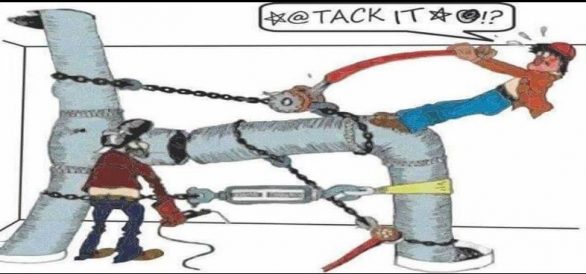Not only do we write blog articles at VibrAlign, we also read them. Nearly every training session I conduct, pipe strain as a source of alignment frustration, comes up.
I recently came across an excellent blog written by Ricky Smith CRL CMRP CMRT that I would like to share. There is some really good information here and well worth the read.

Maintenance Tip – Pipe Stress
Published on May 2, 2018
Pipe stress is caused by misalignment of the mating surfaces of two pipe flanges creating abnormal internal stress of pump bearings, seals, motor bearings, couplings, and can possibly change the displacement of a pump.

General Rules which must be followed by maintenance personnel and contractors: (if you truly want to stop a long-term pump problem).
- Pipe Flanges attached to pumps must be aligned where the gap does not exceed the thickness of two gaskets or tolerance established by your company’s engineering standards.
- Pipe flange bolts must drop in without assistance.
- Cable pullers, come-a-longs, or long bars should not be used when aligning a flange which is connected to a pump.
- Validate the elimination of pipe stress by following the guidelines listed below.
WARNING: Ensure your contractors follow the same process to eliminate pipe stress. Pipe stress elimination should be validated during commissioning of a new pump.
Follow this process if you want to inspect your pumps which may have pipe stress:
- Align the two shafts between your pump and driver (typically an electric motor) to tolerance recommended by the equipment vendor or your company’s engineering standards.
- Validate misalignment to insure motor and pumps shafts are aligned to specification.
- Disconnect the outlet flange on the pump.
- Re-validate laser alignment of shafts.
- If alignment has moved then you have pipe stress. Do the same for the inlet flange.
- Make corrections as stated in the following procedures to eliminate pipe stress.
Elimination of Pipe Stress – “The Ricky Smith Method for Pipe Stress” as learned from Dan Turner (my maintenance and engineering manager at Exxon during my career in the 1970s)
- Bolt flanges to pump and insert blind flange gasket along with two regular flanges between pump and mating flanges. (cover the hole between welding area and inside the pump)
- Attached welding ground to flange. (do not attach ground lead to pump; welding group must always be attached to flange) Warning: failure to accomplish this one task properly will cause bearing failure by “electric arcing” which is a failure mode of bearings.
- Tack weld flange into place reverse welding each tack.
- Allow to cool for 10 minutes.
- Reverse stitch weld on opposite sides on the flange similarly used for cast iron welding.
- After initial reverse stitch weld then weld normally using electrode recommended by the American Welding Society (typically E-6010 5P or GTAW)
- After root pass; weld in any direction you wish.
- Allow to cool and then disconnect flange, replace gaskets and;
– Validate bolts will drop into holes without pry bar
– Validate gap between flanges is no more than two gaskets thick.
Your experience, thoughts, and comments are always appreciated.
Written by

Ricky Smith CRL CMRP CMRT
Maintenance and Reliability Education Provider – “World Class Maintenance LLC”




5 Comments
hi,
good description of procedure. Can you please elaborate the following point:
in what sequence should the field joints be made i.e. weld at flange then spool to header or fisrst weld spool to header and then weld the flange. ?
The correct procedure is to install piping from the pump to the header. Most pipe fitters will prefabricate the spool piece with the flange prior to installation.
how to remove an already strained pipe flange where bolts are not freely dropping
Tanmoy, to correct the pipe strain you described, the pipes will need to be cut and reworked so the pipe flange will match the pump flange for the bolts to “drop in” the bolts holes.
I am having trouble visualizing the first step: “Bolt flanges to pump and insert blind flange gasket along with two regular flanges between pump and mating flanges. (cover the hole between welding area and inside the pump)”. Are you basically stating that an additional set of flanges needs to be added to the pipe spool?